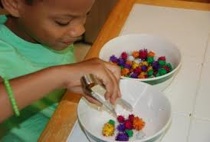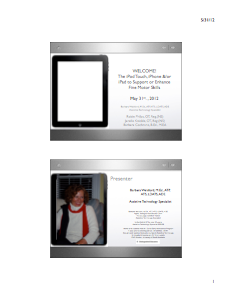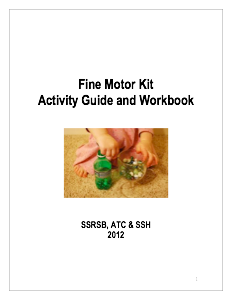Project Products
Project Outline

Webinar Powerpoint Handout
The Development of Activity Kits to Enhance Fine Motor Skills in Elementary Students and Students with Significant Motor Disabilities
1. Project Description and Rationale
Fine motor is the ability to coordinate the small muscles of the hand. Tasks requiring fine motor skills include grasping, picking up small or large items, release, imitating and copying patterns, handwriting, using scissors and many more activities performed in early elementary classrooms. All children will benefit from opportunities to enhance the development of fine motor skills. Occupational Therapists in our school board note that 90% of their referrals are for fine motor skill support. What they are seeing are children who cannot grasp a pencil and paper appropriately, manipulate and pick up small objects to complete a task, use scissors, engage in hand eye coordination activities, utilize manipulatives etc. Children who have difficulties with fine motor readiness skills have difficulties later on with pencil grasp, printing and writing, string beads, dressing oneself (use of buttons, zippers etc). Students with significant disabilities often display difficulties with fine motor skills. Fine motor skills also come into play when stacking blocks, playing with toys, developing control in their environment and also during eating and drinking. Effective fine motor skills are critical to success in school. We are seeing many students enter school and in early elementary who lack efficient fine motor skills to engage in and complete classroom tasks. This project will address those needs.
a)Goals of this project:
To enhance fine motor skills in elementary students and students with significant disabilities through the development of Fine Motor Activity Kits and digital guides for use in classrooms and learning centres.
2. Project Team
The project team will include Barbara Cochrane (Consultant of Program Planning, SSRSB), Barbara Welsford (Assistive Technology Specialist SSRSB), Robin Philp (OT SRH in partnership with SSRSB) various Primary Teachers and Elementary Resource Teachers.
3. Project Design, Innovation and Implementation
•Design Fine Motor Development Kits utilizing various affordable and accessible purchased items from local stores and some specialized items from Flaghouse Special Populations catalogue
•Purchase items related to the kits
•Package items in kits
•Design and publish a digital How-To-Utilize guide that will be distributed with all kits
•Offer training on kit implementation and use to various Learning Centre and classroom teachers
•Distribute the kits and monitor use and application
Timeline:
Once the project has been approved we will begin immediately identifying appropriate materials for the kits, matching them to activities and developing the fine motor digital guides. We anticipate beginning in May 2012 and finishing the project (with evaluation of the project and report writing by May 2013).
All kits and the guide will provide a list of materials and where to make the purchases should the school teams want to develop additional kits.
This project is highly innovative and responding to the needs of young students both entering our school system and those already attending school who are experiencing difficulties with fine motor activities and achieving various outcomes in class. Affordable fine motor kits with an associated guide on effective use and implementation are simply not available. Teachers have noted great interest in this idea and look forward to being training and receiving the kits to use with the large number of students experiencing fine motor difficulties.
20 + schools will be involved in this project in the SSRSB.
4. Project Links to Public School Program and Essential Graduation Learnings
A few of the Primary outcomes identify the need for fine motor skills to engage in and complete the activities. This project will develop skills to support students who don’t have these skills (primary or elementary students with significant motor disabilities) to work towards developing these outcomes.
GC 08: students will be expected to use writing and other forms of representation to explore, clarify, and reflect on their thoughts, feelings, experiences, and learnings; and to use their imagination
9.1 create written media text using some familiar farms [e.g. lists, letters, personal narratives, retellings, messages, finger plays, drawings, puppetry] 9.2 demonstrated beginning of awareness of audience and purpose
GC 0: students will be expected to use a range of strategies to develop effective writing and media products to enhance their clarity, precision, and effectiveness.
10.2 students would be expected to use some conventions of written language
– Use drawings, letters, and approximations to record meeting meaning
– Develop the concept of directionality left to right; top to bottom
– Establish one-to-one correspondence between spoken and written words
– Begin to use spacing between words
– Write complete sentences although they are not always punctuated correctly with.
– Understand that letters can be written in a Bryn Mawr case forms but often tend to use them indiscriminately
Mathematics:
students will be expected to:
•sort sets on the basis of number
•count to determine the number in a group
•Create sets of a given number
•See one copy and extend patterns including those involving number, shape, size calming color
•Copy patterns based on measurements attributes
•Create patterns
•Represent the same pattern in multiple ways
•Recognize, name, describing compare 3-D shapes sort and build with 2-D and 3-D shapes
•Pattern with 2-D and 3-D shapes
10.3 students will be expected to demonstrate engagements with writing and other forms of representation
– Choose to write when given a choice of activities
–express self in writing
– Sustain engagement in writing and other forms of representation for example creating with blocks or paint, role-playing, telling a story through drawing and writing
– Writing play situations for example making grocery list, making signs, Playskool, preparing menus
– Engage in writing and representing activities every day
– Share writing and other representations willingly with others
5. Curriculum Connections
The development of fine motor skills is critical to success throughout school. Tasks like writing, typing, manipulating objects, cutting with scissors, engaging in and controlling one’s environment all rely on fine motor skills, motor planning and various executive functions. This project will develop affordable kits and a fine motor guide that will be distributed to learning centres and elementary classrooms in the SSRSB. The connections of fine motor skill development utilizing tools in the kit and how they are tied ultimately to the curriculum are noted above.

















